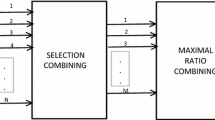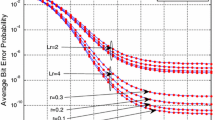Abstract
The performance of antenna diversity coherent and differentially coherent linear multiuser receivers is analyzed in frequency-nonselective Rayleigh fading CDMA channels with memory. The estimates of the complex fading processes are utilized for maximal-ratio combining and carrier recovery of the coherent multiuser receiver. To analyze the impact of channel estimation errors on the receiver performance, error probability is assessed directly in terms of the fading rate and the number of active users, showing the penalty imposed by imperfect channel estimation as well as the fading-induced error probability floor. The impact of fading dynamics on the differentially coherent decorrelating receiver with equal-gain combining is quantified. While performance of multiuser receivers at lower SNR is determined by both the fading dynamics and the number of active CDMA users, performance at higher SNR is given by an error probability floor which is due to fading only and has the same value as in a single-user case. The comparison of the two receiver structures indicates that the coherent decorrelating receiver with diversity reception may be preferable to the differentially coherent one in nonselective fading CDMA channels with memory.
Similar content being viewed by others
References
G.Turin, “The effects of multipath and fading on the performance of direct sequence CDMA systems,” IEEE J. on Selected Areas in Commun., Vol. SAC 2, pp. 597–603, 1984.
M.Kavehrad, “Performance of nondiversity receivers for spread spectrum in indoor wireless communications,” ATT Tech. J., Vol. 64, pp. 1181–1985, 1985.
C.Kchao and G.Stuber, “Performance analysis of a single cell direct sequence mobile radio system,” IEEE Trans. Commun., Vol. 41, pp. 1507–1516, 1993.
S. Verdu, “Adaptive multiuser detection,” in Proc. IEEE Third International Symposium on Spread Spectrum Techniques and Applications (ISSSTA'94), Oulu, Finland, 1994, pp. 43–50.
A.Duel-Hallen, J.Holtzman, and Z.Zvonar, “Multiuser detection for CDMA systems,” IEEE Personal Commun. Mag., Vol. 2, pp. 46–58, 1995.
W.Lee, “Overview of cellular CDMA,” IEEE Trans. on Vehic. Technol., Vol. 40, pp. 291–302, 1991.
R.Haeb and H.Meyr, “A systematic approach to carrier recovery and detection of digitally phase modulated signals on fading channels,” IEEE Trans. Commun., Vol. 37, pp. 748–754, 1989.
P.Kam, “Optimal detection of digital data over the nonselective Rayleigh fading channel with diversity reception,” IEEE Trans. Commun., Vol. 39, pp. 214–219, 1991.
Z. Zvonar and D. Brady, “On multiuser detection in asynchronous CDMA flat Rayleigh fading channels,” in Proc. PIMRC'92, Boston, MA, 1992, pp. 123–127.
S. Vasudevan and M. Varanasi, “Receivers for CDMA communication over time-varying Rayleigh fading channels,” in Proc. Second Communication Theory Mini-Conference, Houston, TX, 1993, pp. 60–64.
E.Lutz et al., “The land mobile satellite communication channel: statistics and channel model,” IEEE Trans. on Vehic. Technol., Vol. 40, pp. 375–486, 1991.
R.Lupas and S.Verdu, “Near-far resistance of multiuser detectors in asynchronous channels,” IEEE Trans. Commun., Vol. 38, pp. 496–508, 1990.
M.Varanasi, “Noncoherent detection in asynchronous multiuser channels,” IEEE Trans. Inform. Theory, Vol. 39, pp. 157–176, 1993.
S. Wijayasuriya, G. Norton, and J. McGeehan, “A near-far resistant algorithm to combat effects of fast fading in multi-user DS-CDMA systems,” in Proc. PIMRC'92, Boston, MA, 1992, pp. 645–649.
S. Wijayasuriya, G. Norton, and J. McGeehan, “A novel algorithm for dynamic updating of correlator coefficients in mobile DS-CDMA,” in Proc. 4th International Symposium on Personal, Indoor and Mobile Radio Communications, Yokohama, Japan, 1993, pp. 292–296.
P.Henrici, Applied and Computational Complex Analysis, Vol. 3, John Wiley & Sons: New York, 1974.
P.Jung, J.Blanz, M.Nasshan, and P.Baier, “Simulation of the uplink of JD-CDMA mobile radio systems with coherent receiver antenna diversity,” Wireless Pers. Commun., An Internat. J., Vol. 1, pp. 61–90, 1994.
B.Steiner and P.Jung, “Optimum and suboptimum channel estimation for the uplink of CDMA mobile radio systems with joint detection,” Euro. Trans. on Telecommun., Vol. 5, pp. 39–50, 1994.
Z. Zvonar and D. Brady, “A comparison of differentially coherent and coherent multiuser detection with imperfect phase estimates in a Rayleigh fading environment,” in Proc. 1993 International Symposium on Information Theory, San Antonio, TX, 1993, p. 48.
Z. Zvonar and M. Stojanovic, “Performance of multiuser diversity reception in nonselective Rayleigh fading CDMA channels,” in Proc. Third Communication Theory Mini-Conference (CTMC'94), San Francisco, CA, 1994, pp. 171–175.
S. Miller and S. Schwartz, “Parameter estimation for asynchronous multiuser communications,” in Proc. 1989 Conference on Information Sciences and Systems, John Hopkins University, 1989, pp. 294–299.
R. Haeb, “A comparison of coherent and differentially coherent detection schemes for fading channels,” in Proc. VTC'88, 1988, pp. 364–370.
J.Proakis, Digital Communications, McGraw Hill: New York, 1995.
M.Stojanovic, J.Proakis, and J.Catipovic, “Analysis of the impact of channel estimation errors on the performance of a decision feedback equalizer in multipath fading channels,” IEEE Trans. Commun., Vol. 43, pp. 877–886, 1995.
B.D.Anderson and J.R.Moore, Optimal Filtering, Prentice Hall: Englewood Cliffs, NJ, 1989.
J.Seymour and M.Fitz, “Two-stage carrier synchronization techniques for nonselective fading,” IEEE Trans. Vehicular Tech., Vol. 44, pp. 103–110, 1995.
H. Wu and A. Duel-Hallen, “Channel estimation and multiuser detection for frequency-nonselective fading synchronous CDMA channels,” in Proc. 32 Allerton Conference on Communication, Control and Computing, pp. 335–344, 1994.
Author information
Authors and Affiliations
Rights and permissions
About this article
Cite this article
Zvonar, Z., Stojanovic, M. Performance of antenna diversity multiuser receivers in CDMA channels with imperfect fading estimation. Wireless Personal Communications 3, 91–110 (1996). https://doi.org/10.1007/BF00333925
Issue Date:
DOI: https://doi.org/10.1007/BF00333925




